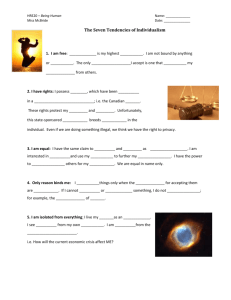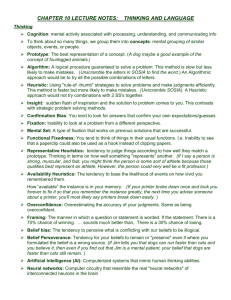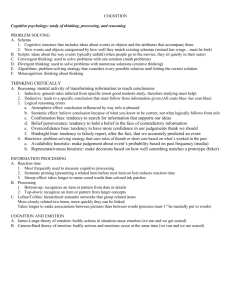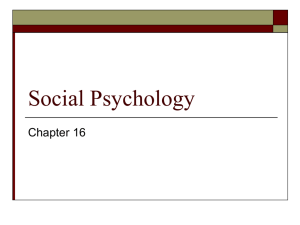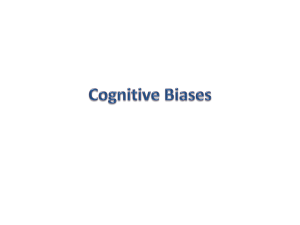Occam's razor
advertisement
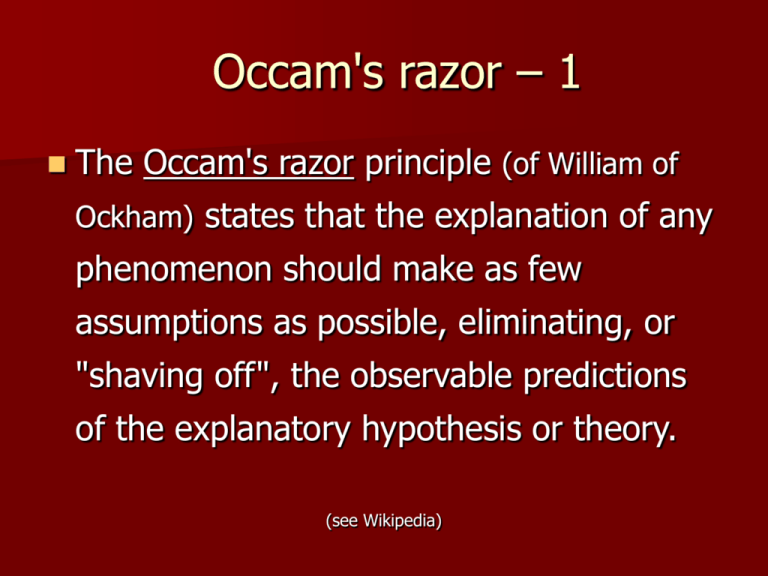
Occam's razor – 1 The Occam's razor principle (of William of Ockham) states that the explanation of any phenomenon should make as few assumptions as possible, eliminating, or "shaving off", the observable predictions of the explanatory hypothesis or theory. (see Wikipedia) Occam's razor – 2 Given two equally valid explanations for a phenomenon, one should embrace the less complicated formulation. And, when multiple competing theories have equal predictive powers, select those that introduce the fewest assumptions and the fewest hypothetical entities. Bias Critical thinking does not assure that one will reach either the truth or correct conclusions. First, one may not have all the relevant information; indeed, important information may remain undiscovered, or the information may not even be knowable. Second, one's biases may prevent effective gathering and evaluation of the available information. Bias types Decision making biases Behavioural biases Biases in probability and belief Social biases Decision making + behavioural biases 1 Bandwagon effect - the tendency to do or believe things because many others do or believe the same. Bias blind spot - the tendency not to compensate for one's own cognitive biases. Choice-supportive bias - the tendency to remember one's choices as better than they actually were. Confirmation bias - the tendency to search for or interpret information in a way that confirms one's preconceptions. Decision making + behavioural biases 2 Congruence bias - the tendency to test hypotheses exclusively through direct testing, without considering testing their consequences. Contrast effect - the enhancement or diminishment of a weight or other measurement when compared with recently observed contrasting object. Decision making + behavioural biases 3 Disconfirmation bias - the tendency to extend critical scrutiny to information which contradicts prior beliefs, and to accept uncritically information that is congruent with prior beliefs. Endowment effect - the tendency to value something more as soon as you own it. Decision making + behavioural biases 4 Focusing effect - prediction bias occurring when you place too much importance on one aspect of an event; causes error in accurately predicting the utility of a future outcome. Hyperbolic discounting - the tendency to have a stronger preference for more immediate payoffs relative to later payoffs, the closer to the present time both payoffs are. Decision making + behavioural biases 5 Illusion of control - the tendency to believe you can control or at least influence outcomes which you clearly cannot. Impact bias - the tendency to overestimate the length or the intensity of the impact of future feeling states. Information bias - the tendency to seek information even when it cannot affect action. Decision making + behavioural biases 6 Loss aversion - the tendency to strongly prefer avoiding losses over acquiring gains. Neglect of probability - the tendency to completely disregard probability when making a decision under uncertainty. Mere exposure effect - the tendency to express undue liking for things merely because they are familiar to you. Decision making + behavioural biases 7 Omission bias - The tendency to judge harmful actions as worse, or less moral than equally harmful omissions (inactions). Outcome bias - the tendency to judge a decision by its eventual outcome instead of based on the quality of the decision at the time it was made. Planning fallacy - the tendency to underestimate task-completion times. Decision making + behavioural biases 7 Post-purchase rationalization - the tendency to persuade oneself through rational argument that a purchase was good value. Pseudocertainty effect - the tendency to make risk-averse choices if the expected outcome is positive, but make risk-seeking choices to avoid negative outcomes. Decision making + behavioural biases 8 Rosy retrospection - the tendency to rate past events more positively than you had actually rated them when the event occurred. Selective perception - the tendency for expectations to affect perception. Status quo bias - the tendency to like things to stay relatively the same. Decision making + behavioural biases 9 von Restorff effect - the tendency for an item that "stands out like a sore thumb" to be more likely remembered than other items. Zero-risk bias - preference for reducing a small risk to zero over a greater reduction in a larger risk. Biases in probability and belief - 1 Ambiguity effect - the avoidance of options for which missing information makes the probability seem "unknown". Anchoring - the tendency to rely too heavily, or "anchor", on one trait or piece of information when making decisions. Anthropic bias - the tendency for one's evidence to be biased by observation selection effects. Attentional bias - neglect of relevant data when making judgments of a correlation or association. Biases in probability and belief - 2 Availability heuristic - a biased prediction, due to the tendency to focus on the most salient and emotionally charged outcome. Belief bias - the tendency to base assessments on personal beliefs. Belief overkill - the tendency to bring beliefs and values together so that they all point to the same conclusion. Clustering illusion - the tendency to see patterns where actually none exist. Biases in probability and belief - 2 Conjunction fallacy - the tendency to assume that specific conditions are more probable than general ones. Gambler's fallacy - the tendency to assume that individual random events are influenced by previous random events - "the coin has a memory". Hindsight bias - sometimes called the "I-knew-itall-along" effect, the inclination to see past events as being predictable. Biases in probability and belief - 3 Illusory correlation - beliefs that inaccurately suppose a relationship between a certain type of action and an effect. My side bias - the tendency for people to fail to look for or to ignore evidence against what they already favour. Neglect of prior base rates effect - the tendency to fail to incorporate prior known probabilities which are pertinent to the decision at hand. Biases in probability and belief - 4 Observer-expectancy effect - when a researcher expects a given result, and therefore unconsciously manipulates an experiment or misinterprets data in order to find it. Overconfidence effect - the tendency to overestimate one's own abilities. Polarization effect - increase in strength of belief on both sides of an issue after presentation of neutral or mixed evidence, resulting from biased assimilation of the evidence.


